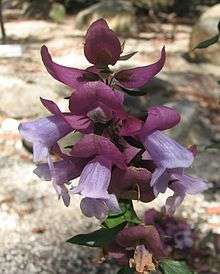Prostanthera magnifica
Prostanthera magnifica, commonly known as magnificent prostanthera, is a flowering plant in the family Lamiaceae. It is endemic to Western Australia. The species is a shrub growing to between 0.4 and 2.5 metres high.[2] The flowers are mauve to pink and are framed by large, purplish-red calyces.[3] These appear between August and November in the species' native range.[2]
| Prostanthera magnifica | |
|---|---|
 | |
| Scientific classification | |
| Kingdom: | Plantae |
| Clade: | Tracheophytes |
| Clade: | Angiosperms |
| Clade: | Eudicots |
| Clade: | Asterids |
| Order: | Lamiales |
| Family: | Lamiaceae |
| Genus: | Prostanthera |
| Species: | P. magnifica |
| Binomial name | |
| Prostanthera magnifica | |
The species was first formally described by botanist Charles Austin Gardner in 1942 in Journal of the Royal Society of Western Australia.[1]
The species occurs in woodland on sand, loam or clay soils.[2][3]
Cultivation
Prostanthera magnifica prefers a sunny or partly shaded position in well-drained soil. It is sensitive to both frost and humidity. Propagation is successful from both seed and cuttings, though seed germination is slow. Grafting is often used to produce a longer-living plant with rootstocks including Westringia fruticosa and Prostanthera striatiflora. The latter gives rise to plants with a longer flowering period and less unwanted growth below the graft.[3]
References
- "Prostanthera magnifica". Australian Plant Name Index (APNI), IBIS database. Centre for Plant Biodiversity Research, Australian Government, Canberra. Retrieved 24 May 2011.
- "Prostanthera magnifica". FloraBase. Western Australian Government Department of Parks and Wildlife.
- "Prostanthera magnifica". Australian Native Plant Society Australia. Retrieved 24 May 2011.